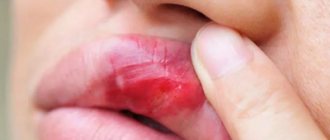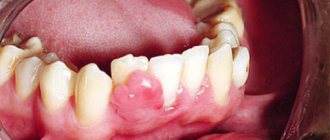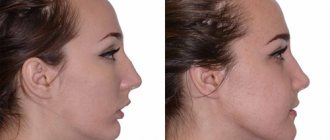The diagnosis of macroglossia is made if the tongue becomes excessively enlarged and thickened. With macroglossia, this muscular organ is pathologically changed or has some anomalies in its structure. This usually occurs due to developmental disorders of the fetus or is a consequence of some pathological process in the body. With this disease, the tongue becomes covered with folds, which further interfere with its proper dynamics. More often the disease occurs in childhood.
If the normal weight of the tongue is from 60 to 80 grams, then with this pathology it “grows” to 120 grams or more.
Both the entire organ and its individual parts (lateral surfaces, back or tip) can increase in size. Because of this, teeth marks may be imprinted on it. Often the tongue may not fit in the mouth and protrude outward.
Macroglossia - causes of tongue enlargement and consequences of the anomaly
From time immemorial, language has served as the main indicator of human health. Any changes in its appearance and structure, the appearance of plaque and neoplasms are all direct signals that some pathological processes are occurring in the body. One of the most serious phenomena is considered to be an increase in the size of the main speaking organ. This condition is medically called macroglossia. Further in this material we will talk about what it is, why such an anomaly occurs in adults and children, what methods are used today to treat the pathology.
Top 10 people with the longest tongue in the world
- Stephen Taylor is a giant human tongue.
- Nick Stoberl is more than anyone in the world.
- Annika Irmler is the longest female tongue.
- Nick Afanasyev - success thanks to language.
- Chanel Tapper is the most unique girl.
- Adrianna Lewis is funny and quirky.
- Byron Schlenker has the biggest tongue.
- Emily Schlenker is a young world record holder.
- Yagya Katuwal is a very original person.
- Radmila Yusupova is a smiling girl.
What is a pathological phenomenon?
Macroglossia or enlarged tongue syndrome can be regarded as an anomaly in the development of an organ or a pathological deformation of its shape due to a certain disease. The tongue becomes denser, may partially or completely increase in size and even protrude outside the mouth if it no longer fits inside. Certain changes occur in the structure of the organ, due to which its surface becomes covered with numerous folds and becomes rough. All this leads to severe discomfort, the inability to fully chew food and breathe freely.
Enlarged tongue syndrome
Carrying out diagnostics
It is best to diagnose macroglossia in utero. Currently, with ultrasound of the fetus, norms for the size of any of its organs at various stages of pregnancy have been developed. There are optimal sizes for the length and width of the tongue. Often, during intrauterine examination, protrusion of the tongue outside the mouth is noticeable.
The final conclusion is given by specialists after several ultrasound examinations over 1 – 2 months.
More often, a full diagnosis can be established only by the 30th week of pregnancy.
After the birth of a baby with this pathology, he will need a number of consultations with an ENT doctor, an infectious disease specialist, a geneticist, an endocrinologist, and an oncologist.
And only after a detailed examination (using clinical analysis and instrumental methods) is a treatment plan for the disease developed.
Causes of macroglossia
Most often, the cause of the development of anomalies is congenital pathologies. Thus, the cause of the problem in newborns may be a benign neoplasm that began to grow at the stage of intrauterine development of the fetus, or an idiopathic disease with muscular hypertrophy of the tongue. Other possible prerequisites, dental experts include, are negative influences and conditions during pregnancy, acute infections, radiation exposure, alcohol poisoning, and hereditary factors. Experts also identify a number of genetic disorders, including the formation of cysts in the oral cavity during the formation of the tongue muscles1.
Read more about childhood tongue diseases in our special article>>>
“By the way, I also had no idea about this disease until a work colleague encountered something similar. As far as I understand, something went wrong during pregnancy, and the child was diagnosed with a congenital cyst on the tongue. I had to undergo surgery, and rehabilitation was not easy. It seems like everything is fine with the baby now...”
Kim7, Izhevsk, from correspondence on the woman.ru forum
As for adult patients, in this case macroglossia can result from the following phenomena and processes:
- malfunction of the thyroid gland, hormonal disorders,
- absence of all teeth in the mouth - complete edentia,
- open bite,
- amyloidosis – a disorder of protein metabolism,
- glycogenosis – disorders of the synthesis and breakdown of glycogen,
- pellagra is one of the forms of vitamin deficiency,
- rhinoscleroma – formation of nodules on the mucous membrane of the oral cavity and nasopharynx,
- syphilis, tuberculosis,
- neoplasms of both benign and malignant nature,
- inflammatory processes accompanied by the formation of pus,
- angioedema in acute form,
- “flaccid” tongue syndrome, characteristic of neurological disorders,
- intramuscular hemorrhage,
- candidiasis (fungal infections),
- malfunctions of the hematopoietic system,
- catarrhal glossitis.
There can be many causes of the pathology.
Sometimes a severe allergic reaction can provoke the problem. Also in medical practice, there are cases when the patient’s overweight becomes a prerequisite for pathology.
Therapeutic effect
When choosing the type of therapy, the doctor takes into account the form of the disease and the cause of its origin. If this pathology is caused by a secondary disease, the cause should be treated in parallel. The general treatment algorithm involves the use of the following medications:
- antibacterial drugs that are used orally or injected;
- antiseptic solutions that are used for local treatment of the surface of the muscular organ;
- the use of anti-inflammatory drugs for treating the tongue.
When treating the main disease that caused macroglossia, with an integrated approach, medications have a positive effect on the organ, it gradually becomes smaller in size. The therapy is long-term, the duration of the course of taking medications is determined by the treating doctor. It is also necessary to undergo regular examinations, since treatment adjustments may be necessary as the patient recovers.
Characteristic symptoms
In order to respond to a problem in a timely manner, you need to know what signs to recognize it. Here are the main symptoms of macroglossia:
- enlarged tongue, to the point where the organ no longer fits in the oral cavity,
- dryness of mucous membranes,
- difficulty breathing, asthma attacks,
- difficulty chewing and swallowing food,
- lumpy surface of the tongue
- enlarged taste buds
- excessive salivation,
- inability to close your mouth normally,
- formation of bleeding cracks on the back,
- diction problems,
- often an increase in temperature, the addition of common infections.
With this pathology, it is impossible to close the mouth normally.
Gradually, the patient’s condition worsens, the bite is deformed, and ulcers appear on the back of the organ. The area around the mouth becomes inflamed and irritation occurs.
Emily Schlenker - uniqueness by inheritance
The girl is the daughter of the previous world record holder; her uniqueness was inherited. The width of the organ is smaller than that of her father and is 7.3 cm, however, she and her father were included in the Guinness Book of Records as the couple with the largest tongues in the world.
Emily Schlenker is the daughter of the most tongue-in-cheek dad
When the father suggested that the child register a world record together, she didn’t even want to hear about it. But after repeated measurements, finally making sure that Emily’s oral organ was indeed larger, wider than the recorded record holder, although smaller than her father’s, the decision was made to submit an application.
How is macroglossia treated today?
The treatment method is selected taking into account the reasons that led to the increase in the size of the tongue. The doctor also takes into account all the changes that have occurred during the development of the disease. In the event that macroglossia is the result of some systemic disease, the root cause of the disease is treated first.
Drug therapy
We already said above that the problem may be the result of an infectious infection. In this case, specialists usually prescribe drug therapy aimed at eliminating the causative factor. As a rule, these are antibiotics, drugs that help normalize metabolic processes, restore the functioning of blood and lymphatic vessels, and agents that stimulate tissue regeneration. Special medications may also be prescribed to treat the surface of the tongue and oral mucosa in order to relieve swelling and inflammation.
If the cause of the pathology is an infection, then antibiotics are prescribed
Surgery
When the situation becomes more serious, surgery may be required. Typically, the surgical method is used to correct a birth defect, immediately after the birth of a child. There are several methods of such treatment:
- resection of the affected organ area,
- phlebectomy or sclerotherapy - usually performed when the cause of the disease is malfunction of the blood vessels. When performing a phlebectomy, the doctor removes damaged vessels, and in the second, he injects a special drug that stimulates the restoration of their functionality,
- blocking the lingual artery - this method is usually used when a child needs treatment at the stage of active growth. In this way, it is possible to minimize the supply of hormones, and the size of the tongue begins to return to normal,
- trimming the frenulum - the organ is raised to maximum tension, after which the frenulum is shortened to 1.5 cm. An advantage is the fact that the operation does not require sutures.
In some cases, surgical intervention is required.
The optimal treatment option is an integrated approach to treatment. The fastest and highest quality results can be achieved by combining drug therapy and surgical treatment.
What parents should pay attention to and be wary of
- Breathing through the mouth if the child does not have a runny nose.
- No gaps between teeth by 4-5 years.
Baby teeth are small and there is usually always room for them, even if the jaw has not developed enough. As the child grows up and prepares for a mixed dentition, so-called trema should appear between the baby teeth - small but distinct distances. When baby teeth fall out, permanent teeth will erupt, which are much wider than baby teeth, and they should have enough space for normal growth and the formation of an even, beautiful dentition.
- Observe the child’s swallowing of saliva; normally, swallowing occurs imperceptibly, without tension in the facial muscles.
Usually, during an appointment, a pediatric dentist draws the attention of parents to the emerging problems of forming a correct bite and refers such children to an orthodontist.
If this does not happen, it is necessary to show the child at the age of 4-5 years to a pediatric orthodontist, preferably one who takes into account the functional approach in his work.
What could be the consequences if treatment is not started on time?
Macroglossia is not just an aesthetic defect, but a serious pathological phenomenon that can lead to dangerous consequences. Among the possible negative developments, dental experts highlight the following phenomena:
- serious disruptions in the functioning of the lungs, frequent cases of asphyxia, which in the worst circumstances can even lead to death,
- the formation of malocclusion in children, which also negatively affects the condition of the body as a whole,
- disturbances in the functioning of the gastrointestinal tract, since with such a pathology it is quite difficult to chew food thoroughly,
- deformation of teeth and soft tissues of the oral cavity,
- speech dysfunction and problems with the patient’s social adaptation.
Frequent biting of the organ, the appearance of cracks and microtraumas cannot be avoided - all this causes serious inconvenience and can provoke the development of an infectious process. It is important to respond to the problem in a timely manner in order to prevent possible complications.
- Matveev, PC Clinical system for diagnosing macroglossia, 2013.









